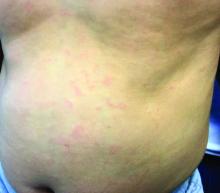Generally, school-aged children are most often affected. Infections are more likely in late winter and early spring. The virus is spread via respiratory secretions, blood products, and transmission from mother to fetus. The cutaneous findings occur about 10 days after exposure to the virus. By that time, the risk of being contagious is low.
Classically, asymptomatic erythema first appears on the cheeks, resembling a “slapped cheek” appearance. Lacy, reticulated erythema then appears on the trunk and extremities 1-4 days later. Lesions often fade over the course of 2-3 weeks, but may persist for longer periods of time. Lesions may be recurrent after exposure to heat, bathing, sunlight, or upon physical activity. Younger children may exhibit mild fever, headache, runny nose, and arthralgias prior to the cutaneous eruption. Arthralgias are more common in adolescents and adults, who may even develop severe arthritis.Healthy individuals have no sequelae from fifth disease and require no treatment. However, in patients with hemoglobinopathies, such as sickle cell disease, an aplastic crisis can be triggered. In patients with deficient immune systems, parvovirus B19 may cause infection and anemia, requiring hospitalization. Pregnant women exposed to parvovirus B19 are at risk for hydrops fetalis and rarely, fetal malformations or fetal demise. Other uncommon associations include hepatitis, vasculitides, and neurologic disease.
Exanthem subitum, or roseola, classically presents in children aged 6 months–3 years. Three to five days of high fevers is followed by pink papules over the entire body. Papular acrodermatitis presents as erythematous papules on the extremities, buttocks, and face, classically sparing the trunk. It is associated with enterovirus, respiratory viruses, and Epstein-Barr virus. Livedo reticularis occurs more often in healthy young women and presents as a persistent, lacy erythema.Dr. Bilu Martin is a board-certified dermatologist in private practice at Premier Dermatology, MD, in Aventura, Fla. More diagnostic cases are available at edermatologynews.com. To submit a case for possible publication, send an email to dermnews@mdedge.com. This case and photo were submitted by Dr. Bilu Martin.



